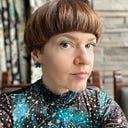
The Nicola Coughlan Discourse Reveals People Have No Idea How Sizes Actually Work
Small and Thin are Two Completely Different Things
When I heard Nicola Coughlan, who plays Penelope in Bridgerton, is a dress size UK10 (which is equivalent to a US6) my petite ass thought, well of course, that makes sense. And then I went on with my day.
“Plus-sized” when the term is used correctly, specifically refers to women who wear a US Size 12 or above. People who are not plus-sized tend to use the term as a generic synonym for “curvy” because they don’t remotely get that. This is why Coughlan unfortunately had to reveal her size in the first place. It’s obvious to her fellow petites that this is a small, round woman — two terms that don’t remotely contradict.
However, it soon became clear that this fact would upset many comment sections across the internet, with some incorrectly suggesting “That’s ridiculous, maybe a size US10” and others still missing with “I’m all for body positivity but she’s bigger than a 6”. Thus, the sum total of discourse reveals how little people understand about how sizes actually work. An awful lot of people believe they can determine someone’s size based on their shape or appearance. But these are two completely different concepts.
For most people, your height is the number one thing that will determine the size range you can wear. Nicola Coughlan is 5' 1" and generally regarded as having a curvy shape. Elizabeth Debicki is 6' 3" and thin. Yet Debicki likely weighs a few pounds more than Coughlan. Internet estimates put Debicki at around 145 pounds, and Coughlan at closer to 125 pounds.
Tall people are not just short people who have been stretched like a pencil. They tend to be larger proportionately as well, and guess what? The same is true in reverse. Debicki clearly has a lower bodyfat percentage than Coughlan, and whatever bodyfat she does have is spread over a long, lithe frame. Coughlan has a higher bodyfat percentage, and short people have a thicker, stockier appearance because what bodyfat and muscle they have doesn’t have many places to go.
Let’s take a curvy 4'11", 110-pound woman with a soft belly and 25% body fat, who is a size 00 in J Crew. Versus a tall, lithe, 130-pound woman with 15% body fat and a flat stomach who is a size 4. The thin woman with the “enviable” shape wears the larger size. HELLO SHITHEADS.
I’m 5' 3". At my smallest, I weighed 110 pounds and had a 22% bodyfat percentage. Guess what motherfuckers? I still wore a 30C bra and the tops of my thighs still touched, because that’s what a lot of petite women tend to look like (but not all). And at least once a year of my adult life, I have had the embarrassing experience of going through the checkout line or entering the dressing room and having some tall salesgirl who is thinner than me make some passive-aggressive remark because she doesn’t understand how my curvy 35" ass could be swimming in a dress size that is too small for her 38" skin and bones. This dynamic is even more humiliating whenever I put on 5 pounds or so, because it doesn’t really effect my measurements or my dress size, but it makes a dramatic difference in my appearance due to my height.
That people are even having these conversations in droves is in itself, sad, of course. Other thinkpieces have aptly addressed why. But I hope people take this as a learning opportunity to correct the conflation of size vs. shape. All shapes come in every size — quite literally.

